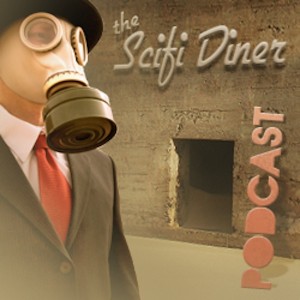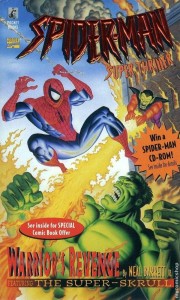One of the complications of being an indie-press publisher and author—sometimes the most frustrating complication of them all—is finding ways to promote your latest release.
You can mail out review copies, send out press releases, make requests for interviews, or even fill out preexisting questions available from a website dedicated to writing (otherwise known as a “self-interview”), but there’s no guarantee you’re going to get media coverage. Still, you do what you can to get attention.
When you’re successful, you wind up with something like my interview with the newspaper The Queens Gazette, which appeared in the print edition and was featured on the paper’s website. Or “Pandora Zwieback and the Bloggy Thing,” a guest post that I was invited to write for the site Writing Belle. Or the cover feature article/interview in IndyFest Magazine #85 (still available for free download). Or my upcoming interview at the site Write a Revolution (I’ll let you know when that gets posted). When you’re unsuccessful, however, you can wind up with completed self-interviews that are passed over by the sites you submitted answers to.
Guess which type of interview this is? 😉 Hey, but why let a completed interview go to waste, right?
Here, you’ll get a little background on my literary history: my first break as an author; my decision to self-publish The Saga of Pandora Zwieback; my thoughts on current publishing trends; and a few other topics. Give it a read—and then (if you haven’t already) purchase a copy of Blood Reign: The Saga of Pandora Zwieback, Book 2. It’ll make all the complications experienced by a small-press publisher worth the effort!
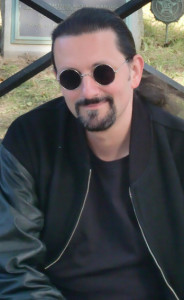 Q: Welcome, Steven. Can we start out by telling us whether you are published for the first time or are you multi-published?
Q: Welcome, Steven. Can we start out by telling us whether you are published for the first time or are you multi-published?
I’m multi-published. In addition to the novels and graphic novels I currently write for my company, StarWarp Concepts (including the Saga of Pandora Zwieback young adult books Blood Feud and Blood Reign), I’m the author of the novels X-Men: The Chaos Engine Trilogy (BP Books/Simon & Schuster) and Final Destination: Dead Man’s Hand (Black Library), the graphic novels Lorelei: Sects and the City, Sunn, and Stan Lee’s Alexa, and a number of short stories and comic book projects for various publishers.
Q: When you were published for the first time, which route did you go—mainstream, small press, vanity published or self-published, and why or how did you choose this route?
Well, I’d written some comic books and short stories early in my writing career, but as a novelist I got my start in 1997 with a mainstream title: the original, licensed novel Spider-Man Super Thriller: Warrior’s Revenge, based on the Marvel Comics character. It was part of a Marvel book series co-published by Byron Preiss Multimedia Company (BPMC) and Simon & Schuster’s Pocket Books imprint. It actually turned out to be a ghostwriting job—the original author’s manuscript had been rejected and I was hired to rewrite the book from scratch, but the covers with his name had already been printed, so I never got cover credit!
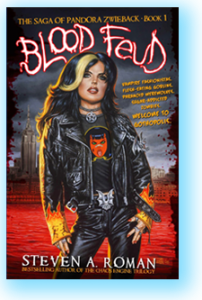 In 2010, I decided to go the self-publishing route by reviving StarWarp Concepts—a publishing company I’d launched in 1993 for my comic book projects—as a book-publishing house. And in 2011, I released my first young adult dark-fantasy novel, Blood Feud: The Saga of Pandora Zwieback, Book 1. The reason I decided to self-publish it was because I’d done the agent-and-editor submission dances, sending a proposal around in hopes of a book deal and/or an author representative, only to have it rejected for some head-scratching reasons. Most of them fell under two categories: “It’s just not right for us,” which is sort of agent-speak for “I just didn’t care for it on a personal level”; and “Could it be more like…?,” which means they’d like you to knock off something successful—at the time I sent the Pandora proposal around, everyone was trying to clone Stephanie Meyer’s Twilight. (Today, it’s things like E. L. James’s 50 Shades of Grey and John Green’s The Fault in Our Stars.)
In 2010, I decided to go the self-publishing route by reviving StarWarp Concepts—a publishing company I’d launched in 1993 for my comic book projects—as a book-publishing house. And in 2011, I released my first young adult dark-fantasy novel, Blood Feud: The Saga of Pandora Zwieback, Book 1. The reason I decided to self-publish it was because I’d done the agent-and-editor submission dances, sending a proposal around in hopes of a book deal and/or an author representative, only to have it rejected for some head-scratching reasons. Most of them fell under two categories: “It’s just not right for us,” which is sort of agent-speak for “I just didn’t care for it on a personal level”; and “Could it be more like…?,” which means they’d like you to knock off something successful—at the time I sent the Pandora proposal around, everyone was trying to clone Stephanie Meyer’s Twilight. (Today, it’s things like E. L. James’s 50 Shades of Grey and John Green’s The Fault in Our Stars.)
So if I’d been willing to rip off Twilight, I might have been signed by any number of agents, but I wasn’t interested in that approach. Self-publishing removed the unpleasantness of dealing with ridiculous, non-constructive feedback.
Q: How long did it take you to get published once you signed the contract?
I think I wrote the Spider-Man novel in a couple of months—with the original manuscript rejected, I had to make up for the book’s lost production time. It was a scary time for me—it was my first novel, someone else’s name was going to be on the cover, and I had to jump right in and start writing. Thankfully, Marvel’s licensing department was happy with the results, and that’s what led to me soon after getting the assignment to write three X-Men novels that sold exceptionally well.
With Blood Feud, it took about a year or so to get it into a shape I was happy with. And then I handed it over to Howard Zimmerman, a friend and former editorial boss of mine, for editing. Once he was done constructively ripping it apart—I wound up rewriting half the book and adding new material, based on his spot-on edits—Blood Feud was finally ready for publication. And based on the feedback and positive reviews I’ve received, it was worth all the effort!
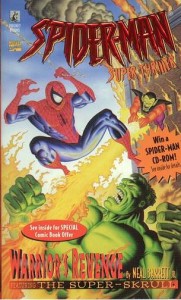 Q: How did it make you feel to become published for the first time and how did you celebrate?
Q: How did it make you feel to become published for the first time and how did you celebrate?
How’d I feel? Like a kid with an intense sugar buzz! I mean, it would’ve been nice to actually have my name on the Spider-Man book, but when I held a copy of the printed novel for the first time, I couldn’t help but be excited by it. And anyway, I finally got my name on the cover when I wrote the X-Men: Chaos Engine Trilogy novels a few years after that, and that was even more exciting!
As for how I celebrated when Warrior’s Revenge came out…I think I treated myself to White Castle hamburgers, or something. Yeah, I know, not the most exciting way to celebrate, but I was happy enough.
Q: What was the first thing you did as far as promotion when you were published for the first time?
With the Spider-Man novel… Unfortunately, neither BPMC nor Simon & Schuster did any promotion for the series as a whole; the books were just sort of put out there with no fanfare. So if a Marvel fan happened to come across Warrior’s Revenge in a bookstore—great! Otherwise, no one really knew it was available. The same thing happened a few years later, when the X-Men novels I wrote were published—but those sold huge numbers in spite of the lack of publicity.
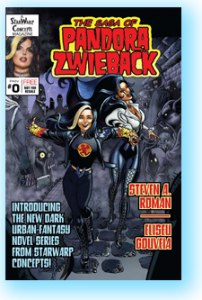 With the Saga of Pandora Zwieback and my other StarWarp Concepts projects, since I’m sort of the master of my own fate—being the publisher as well as the writer—I’m much more proactive in how my work is promoted. I send out press releases and review copies, print up catalogs and brochures, make appearances at horror and comic book conventions and book festivals, heavily blog at the StarWarp Concepts and Pandora Zwieback websites, and set up interviews—like this one! To promote the debut of Blood Feud, the first Pandora Zwieback novel, I published a free full-color comic book, The Saga of Pandora Zwieback #0, that introduces Pan to potential readers, and handed out a couple thousand copies at conventions—and then I made it a free digital comic that can still be downloaded from the StarWarp Concepts site.
With the Saga of Pandora Zwieback and my other StarWarp Concepts projects, since I’m sort of the master of my own fate—being the publisher as well as the writer—I’m much more proactive in how my work is promoted. I send out press releases and review copies, print up catalogs and brochures, make appearances at horror and comic book conventions and book festivals, heavily blog at the StarWarp Concepts and Pandora Zwieback websites, and set up interviews—like this one! To promote the debut of Blood Feud, the first Pandora Zwieback novel, I published a free full-color comic book, The Saga of Pandora Zwieback #0, that introduces Pan to potential readers, and handed out a couple thousand copies at conventions—and then I made it a free digital comic that can still be downloaded from the StarWarp Concepts site.
Q: Since you’ve been published, how have you grown as a writer and now a published author?
I like to think my writing and storytelling continue to improve with each project. Looking back at the Spider-Man novel, I can see the beginnings of my character-driven action stories, but it’s rough in comparison to, say, Blood Reign, the current Pandora Zwieback novel. Pan is probably the most fully realized character I’ve written, but there’s so much more to her story I’m looking forward to exploring.
Q: What has surprised or amazed you about the publishing industry as a whole?
It’s sort of a mixed reaction. On the one hand, the time has never been better to be an author, with the advancements constantly being made in self-publishing tools. On the other, as an editor, copyeditor, and proofreader with over twenty years’ experience, I’m always surprised by the number of self-published authors who haven’t taken the time to really learn their craft—story structure, plotting, consistent story continuity, even correct spelling and punctuation. In those cases, it’s reflective of an attitude I used to run into at conventions, when I’d explain to visitors to my table that I was a writer, not an artist: “Well, anybody can write a novel.” Actually…no, not everybody can. Not without working at it.
That said, there are a lot of talented authors out there who know their business, and those are the ones whose works are worth tracking down. As for the rest…well, even in the worst-written novel you can often see the story the author intended to tell—they just need to keep honing their craft in order to tell it better and clearer.
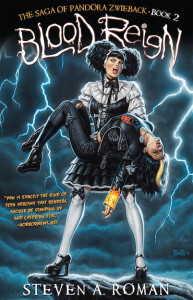 Q: What is the most rewarding thing about being a published author?
Q: What is the most rewarding thing about being a published author?
Discovering that there’s actually an audience out there for the kinds of things I write! When I hear from someone who’s read my Pandora Zwieback work and they tell me how much she reflects their own thoughts and feelings, and is even someone they’d love to hang out with, then I know I’m doing a good job as a writer. And that’s a pretty nice reward!
Q: Any final words for writers who dream of being published one day?
As lame and clichéd as it sounds, keep at it! You can only get better by working your craft, by learning the tools of the trade—by which I mean the publishing “bibles,” Webster’s Dictionary and the Chicago Manual of Style—and by learning to take constructive criticism. I often tell folks that Blood Feud, the first Pan novel, wouldn’t be the critically acclaimed book it is today if I hadn’t listened to my editor when he told me what needed fixing. Do all that, and one of these days you might find your name on the cover of a book, too!
My latest work, Blood Reign, The Saga of Pandora Zwieback, Book 2, is currently available for order from online and brick-and-mortar bookstores and the StarWarp Concepts webstore. Visit the Blood Reign product page at SWC for more information, as well as a sample chapter.

